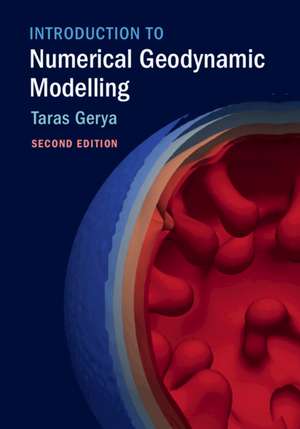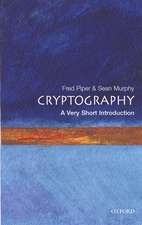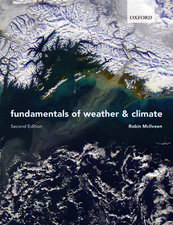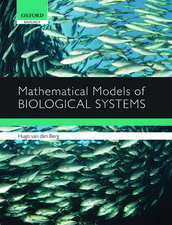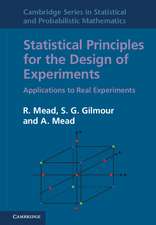Introduction to Numerical Geodynamic Modelling
Autor Taras Geryaen Limba Engleză Hardback – 22 mai 2019
| Toate formatele și edițiile | Preț | Express |
|---|---|---|
| Hardback (2) | 479.44 lei 3-5 săpt. | +41.71 lei 6-12 zile |
| Cambridge University Press – 22 mai 2019 | 479.44 lei 3-5 săpt. | +41.71 lei 6-12 zile |
| Cambridge University Press – 16 dec 2009 | 623.34 lei 6-8 săpt. |
Preț: 479.44 lei
Preț vechi: 521.13 lei
-8% Nou
Puncte Express: 719
Preț estimativ în valută:
91.74€ • 98.10$ • 76.49£
91.74€ • 98.10$ • 76.49£
Carte disponibilă
Livrare economică 28 martie-11 aprilie
Livrare express 13-19 martie pentru 51.70 lei
Preluare comenzi: 021 569.72.76
Specificații
ISBN-13: 9781107143142
ISBN-10: 1107143144
Pagini: 484
Ilustrații: 66 b/w illus. 192 colour illus.
Dimensiuni: 178 x 253 x 28 mm
Greutate: 1.04 kg
Ediția:2Nouă
Editura: Cambridge University Press
Colecția Cambridge University Press
Locul publicării:New York, United States
ISBN-10: 1107143144
Pagini: 484
Ilustrații: 66 b/w illus. 192 colour illus.
Dimensiuni: 178 x 253 x 28 mm
Greutate: 1.04 kg
Ediția:2Nouă
Editura: Cambridge University Press
Colecția Cambridge University Press
Locul publicării:New York, United States
Cuprins
1. The continuity equation; 2. Density and gravity; 3. Numerical solutions of partial differential equations; 4. Stress and strain; 5. The momentum equation; 6. Viscous rheology of rocks; 7. Numerical solutions of the momentum and continuity equations; 8. The advection equation and marker-in-cell method; 9. The heat conservation equation; 10. Numerical solution of the heat conservation equation; 11. 2D thermomechanical code structure; 12. Elasticity and plasticity; 13. 2D implementation of visco-elasto-plasticity; 14. 2D thermomechanical modelling of inertial processes; 15. Seismo-thermomechanical modelling; 16. Hydro-thermomechanical modelling; 17. Adaptive mesh refinement; 18. The multigrid method; 19. Programming of 3D problems; 20. Numerical benchmarks; 21. Design of 2D numerical geodynamic models; Epilogue: outlook; Appendix: MATLAB® program examples; References; Index.
Recenzii
'A great introduction to computational geodynamics with vivid examples, hands-on exercises and step-by-step derivations of formulas. Even better than the first edition.' Sascha Brune, Das Helmholtz-Zentrum Potsdam – Deutsches GeoForschungsZentrum
'This book is so much more than an introduction to geodynamic modelling. Taras Gerya opens the world of geodynamic experiments by taking the reader through a carefully designed set of hands-on programming exercises that will convince you that modelling is not terribly complicated, but a process to logically follow through. Go ahead and get started!' Susanne Buiter, Geological Survey of Norway
'This comprehensive textbook challenges all solid Earth scientists to give geodynamic modelling a try in a hands-on, empowering style. The new edition covers even more ground, including cutting-edge topics. A great achievement, and the community will be the better for it.' Thorsten Becker, University of Texas, Austin
Praise for the first edition: '… the book provides excellent value for those wanting an introduction to the field. Anyone who works carefully through this book and completes all the exercises should be well prepared for further work in geodynamic modelling.' Geoscientist
Praise for the first edition: 'The book is written in a light and engaging style such that it deserves a place on the recommended reading list of any undergraduate or Masters course that includes geodynamics. Additionally, it will be a valuable resource for any geoscientist who wants to include geodynamic modelling within their research activities.' Geological Magazine
'This book is so much more than an introduction to geodynamic modelling. Taras Gerya opens the world of geodynamic experiments by taking the reader through a carefully designed set of hands-on programming exercises that will convince you that modelling is not terribly complicated, but a process to logically follow through. Go ahead and get started!' Susanne Buiter, Geological Survey of Norway
'This comprehensive textbook challenges all solid Earth scientists to give geodynamic modelling a try in a hands-on, empowering style. The new edition covers even more ground, including cutting-edge topics. A great achievement, and the community will be the better for it.' Thorsten Becker, University of Texas, Austin
Praise for the first edition: '… the book provides excellent value for those wanting an introduction to the field. Anyone who works carefully through this book and completes all the exercises should be well prepared for further work in geodynamic modelling.' Geoscientist
Praise for the first edition: 'The book is written in a light and engaging style such that it deserves a place on the recommended reading list of any undergraduate or Masters course that includes geodynamics. Additionally, it will be a valuable resource for any geoscientist who wants to include geodynamic modelling within their research activities.' Geological Magazine
Notă biografică
Descriere
A second edition of this popular introduction to numerical geodynamic modelling theory and applications for graduate students.
